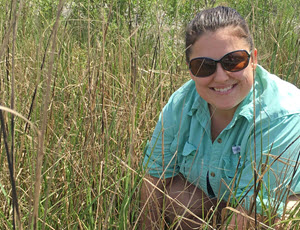
Elizabeth Robinson enjoys field work in Terrebonne Bay studying blue crab in their natural habitat. (Photo provided by E. Robinson)
Elizabeth Robinson studies blue crab’s role in the northern Gulf of Mexico food web, looking closely at how Deepwater Horizon oil might have affected the natural predator-prey balance.
Many people who hear the phrase ‘marine life’ typically think first about big ocean animals like whales and dolphins. Elizabeth explained why smaller marine animals – like crabs – mean just as much to ocean health, “The little guys are what feed the bigger guys. If you lose the little guys, those bigger guys are going to disappear.”
Elizabeth is a GoMRI Scholar with the Coastal Waters Consortium, pursuing a Ph.D. in Oceanography and Coastal sciences at Louisiana State University with research centered at Louisiana Universities Marine Consortium (LUMCON).
Her Path
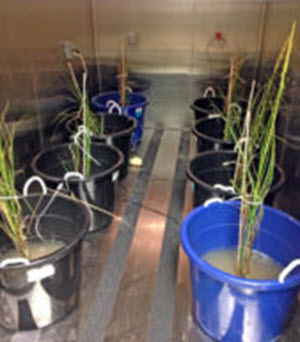
Elizabeth created a mesocosm experiment station to get a better understanding of how crabs behave in their natural environment. (Photo provided by E. Robinson)
Elizabeth credits childhood visits to museums, aquariums, and nature centers and having home aquariums with sparking her interest in marine science. Her parents involved Elizabeth and her hearing-impaired brother in hands-on science learning opportunities whenever possible, encouraging them to learn using all their senses. These early experiences helped Elizabeth feel comfortable around water.
Elizabeth considers Louisiana and its water-rich environment as home even though her family moved many times. Living in Louisiana added a different dimension to her growing interest, as she explained, “The politics around wetlands loss and fisheries have also influenced why I’m in science.” She stayed in the region, earning a bachelor’s degree from Centenary College of Louisiana and a Master’s degree in Biology from Texas A&M University-Corpus Christi. Her thesis was on invasive cold water crab species.
One of Elizabeth’s undergraduate courses was a video conference class from LUMCON, where she worked as a summer intern in Dr. Nancy Rabalais’ lab. Several years later, Elizabeth jumped at the chance to work with Rabalais again, this time as a Ph.D. student. Rabalais leads a multi-year grant studying effects of the Deepwater Horizon oil spill on Louisiana marshes. Elizabeth felt this would be the perfect opportunity to learn how the spill might have impacted crabs.
Her work
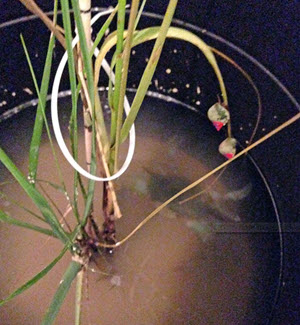
Each mesocosm recreates as accurately as possible conditions in the wild, serving as important tools in ecosystem studies. (Photo provided by E. Robinson)
Elizabeth explained why she chose these marine animals for her dissertation experiments, “Blue crabs are a keystone species. They link benthic and pelagic environments together, are important as a food source, and serve as a control on so many other different species.”
Elizabeth is concurrently running field and lab studies to determine local crab distribution and their response to oil. She scrutinizes snail, oyster, and mussel populations at designated transects in Terrebonne Bay to understand how residual oil might be affecting their population distributions and morphology. Blue crabs eat these species, and Elizabeth explains why this work is the foundation for understanding potential food web changes: “If I’m seeing a high population of snails, is it because crab predators are avoiding certain marshes because of oil? Or can they not find the snails because their behavior has been altered by oil?”
Seeking answers to these and other questions, Elizabeth releases minnow traps to lure juvenile blue crabs and uses scoop nets to catch them. She sizes her catches and then runs various lab experiments to determine oil exposure’s impact on their survival and behavior. One experiment involves exposing crabs to oiled water and then tethering them back in the bay to see if that increases their vulnerability to predation. Healthy crabs bury themselves to escape predators, but Elizabeth is finding that oil-exposed crabs are not responding to threats in a typical manner.
Elizabeth conducts lab experiments to determine how oil affects predator-prey behavior of crabs and snails. She uses oil-exposed crabs in flume experiments to see if oil impacts their ability to find food using chemical cues. Preliminary results show that oil reduces the crab’s chemosensory ability. She also conducts mesocosm experiments – a mini-ecosystem in a controlled chamber – to study crab-snail interactions in oiled sediment. Her initial findings suggest that in this situation, oil makes blue crabs unusually aggressive and they successfully forage for snails. However, crabs in the mesocosm experiments are dependent on visual cues and not utilizing chemical cues as they did in the flume experiment. The oil also reduced snail climbing behavior making them more susceptible to crab predation.
Her learning
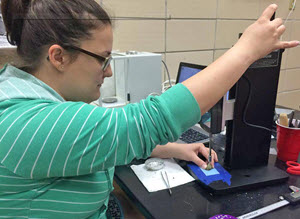
Elizabeth Robinson tests the shell strength of periwinkle snails. She is trying to determine if snail strength differs between locations along the coast. (Photo provided by CWC)
Elizabeth said the diverse projects that GoMRI funds provide a bigger-picture context and raise the bar for everyone involved in oil spill research. “Conferences are a lot to take in,” she explained, referring to the annual meetings where scientists studying the oil spill and the Gulf of Mexico ecosystem gather. “It helps you as a biologist to learn from physicists, chemists, and others what you need to focus on in your experiments.”
She credits the hands-off management style of her advisor Nancy Rabalais with instilling confidence in her own abilities: “She’s taught me a lot about independence, that I can trouble-shoot problems by myself and not rely on anyone to hold my hand.”
Her Future
Elizabeth knows her work will always focus on crabs, even though her career path after graduation isn’t certain. Her aspirations vary from opening up her own marine research facility to serving in regulatory roles in government and/or industry.
Science can be stressful, so Elizabeth cautions those considering pursuing it to have a passion for it. Having that love, she says, creates the tenacity to get scientists through the long hours of frustrating or tedious work often necessary to reach important findings.
Praise for Elizabeth
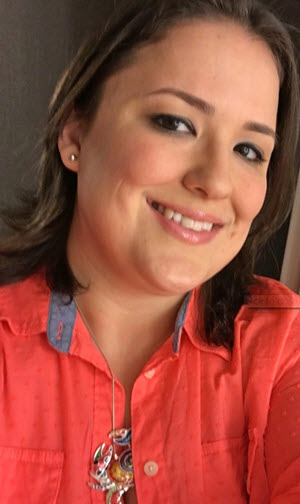
Elizabeth wants to spend her career focused on ‘little guys’ like blue crabs that play such an important role in overall marine health. (Photo provided by E. Robinson)
Nancy Rabalais describes Elizabeth as a dedicated and creative researcher: “She has an exceptional command of experimental biology. She is persistent, modifying as necessary, and thinking through alternative explanations for results in her complex experiments.”
Elizabeth, she says, is an active graduate student who takes advantage of every opportunity. She collaborates with her lab mates, participates in Coastal Ecology informal talks, and attends and presents at professional meetings annually, including the Gulf of Mexico Oil Spill and Ecosystem Science Conference, representing CWC and LUMCON well. Finally, she is active in LSU’s Coast and Environment Graduate Organization, serving as president for the 2013-2014 academic year.
“She has all the qualifications for completion of her Ph.D. —good course performance, writing skills, presentation skills, critical thinking, and a collaborative attitude,” summed up Rabalais.
The GoMRI community embraces bright and dedicated students like Elizabeth Robinson and their important contributions. The GoMRI Scholars Program recognizes graduate students whose work focuses on GoMRI-funded projects and builds community for the next generation of ocean science professionals.
************
This research was made possible in part by a grant from The Gulf of Mexico Research Initiative (GoMRI). The GoMRI is a 10-year independent research program established to study the effect, and the potential associated impact, of hydrocarbon releases on the environment and public health, as well as to develop improved spill mitigation, oil detection, characterization and remediation technologies. An independent and academic 20-member Research Board makes the funding and research direction decisions to ensure the intellectual quality, effectiveness and academic independence of the GoMRI research. All research data, findings and publications will be made publicly available. The program was established through a $500 million financial commitment from BP. For more information, visit http://gulfresearchinitiative.org/.
